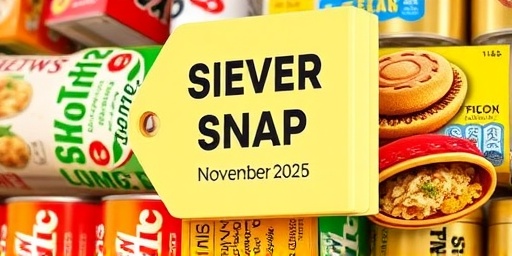As the U.S. government shutdown enters its second week in November 2025, millions of low-income Americans are staring down the barrel of disrupted SNAP benefits, the lifeline food assistance program that feeds over 41 million people monthly. With federal funding frozen amid partisan budget battles, experts warn that benefit cards could go empty by mid-month, exacerbating hunger and straining local economies already battered by inflation.
- SNAP Program Under Siege: How the Shutdown Freezes Food Aid Delivery
- Personal Stories Emerge: Families Grapple with Imminent Food Shortages
- Economic Fallout: Shutdown’s Broader Toll on Retail and Local Economies
- Political Gridlock Exposed: Budget Battles Fueling the Shutdown Crisis
- Emergency Responses and Future Safeguards: Navigating the Path Forward
SNAP Program Under Siege: How the Shutdown Freezes Food Aid Delivery
The Supplemental Nutrition Assistance Program (SNAP), formerly known as food stamps, is a cornerstone of the U.S. social safety net, providing critical food assistance to vulnerable populations including families, seniors, and children. In fiscal year 2024, SNAP disbursed over $119 billion in benefits, helping to combat food insecurity that affects 13.5% of U.S. households according to the USDA’s latest data. But the ongoing government shutdown, triggered by disagreements over spending cuts and border security funding, has halted non-essential federal operations, including those managed by the Department of Agriculture (USDA).
Under normal circumstances, SNAP benefits are loaded onto Electronic Benefit Transfer (EBT) cards at the start of each month. For November 2025, initial distributions occurred before the shutdown on November 5, but subsequent administrative functions—like verifying eligibility, processing renewals, and investigating fraud—have ground to a halt. “This isn’t just a bureaucratic delay; it’s a humanitarian emergency in the making,” said Dr. Elena Ramirez, a policy analyst at the Food Research & Action Center (FRAC). “Without federal staff, states can’t update systems, and that means benefits could lapse for up to 5 million recipients by Thanksgiving.”
Historical precedents underscore the severity. During the 2018-2019 shutdown, which lasted 35 days, SNAP saw temporary waivers allowing states to issue benefits, but those measures required congressional approval that isn’t guaranteed this time. In 2025, with a divided Congress, such waivers remain stalled. Statistics from the Center on Budget and Policy Priorities (CBPP) project that 12% of SNAP households—roughly 5 million people—could face interruptions if the shutdown persists beyond November 15.
- Key Affected Groups: Working poor families (45% of recipients), children in school meal programs (linked to SNAP), and elderly individuals relying on fixed incomes.
- Monthly Impact: Average benefit of $291 per person at risk, totaling potential $1.5 billion in lost food assistance for November alone.
- State Variations: High-reliance states like California (4.5 million recipients) and Texas (3.2 million) face the steepest challenges due to overwhelmed local food banks.
This freeze on SNAP operations isn’t isolated; it ripples through the entire food assistance ecosystem, forcing grocery stores to adapt to potential EBT glitches and charities to brace for influxes of desperate families.
Personal Stories Emerge: Families Grapple with Imminent Food Shortages
In cities across America, the human cost of the government shutdown is becoming starkly visible. Take Maria Gonzalez, a single mother of three in Chicago, who relies on SNAP to stretch her $2,200 monthly fast-food wage. “My EBT card is down to $50, and with the shutdown, I can’t renew my certification,” Gonzalez shared in an interview with local reporters. “My kids are asking for seconds at dinner, but I don’t know how to explain that the government isn’t helping right now.” Her story echoes thousands: the USDA reports that 40% of SNAP users are children, and disruptions could push child hunger rates up by 20% in affected areas.
Further south in Atlanta, senior citizens like 72-year-old Robert Hayes are hit hardest. Hayes, living on a $1,200 Social Security check, uses SNAP for half his groceries. “I’ve seen shutdowns before, but this one feels different—longer and meaner,” he said. Advocacy groups like Feeding America have documented a 15% spike in emergency food pantry visits since the shutdown began, with projections for November 2025 showing a 300% increase in demand if benefits falter.
Quotes from frontline workers paint a dire picture. “We’re seeing lines out the door that rival pandemic levels,” noted Sarah Jenkins, director of a Philadelphia food bank. “SNAP isn’t just aid; it’s dignity for people trying to make ends meet.” Data from the Census Bureau highlights the vulnerability: 18 million U.S. children live in food-insecure homes, and a SNAP lapse could add 2 million more to that tally this month.
These personal narratives aren’t anomalies; they’re harbingers of broader societal strain. Rural areas, where SNAP participation rates exceed 20%, face unique logistics challenges, as shuttered federal offices delay paperwork by weeks. In Native American communities on reservations, where food deserts are common, the shutdown amplifies isolation, with tribal leaders calling for immediate federal intervention.
Economic Fallout: Shutdown’s Broader Toll on Retail and Local Economies
Beyond individual hardships, the government shutdown’s threat to SNAP benefits is poised to deliver a body blow to the U.S. economy, particularly in the retail and agriculture sectors. SNAP injects $23 billion into local economies each month through grocery purchases, supporting 400,000 jobs according to a 2024 USDA economic impact study. With November 2025 benefits at risk, economists estimate a $10-15 billion GDP hit if disruptions last the full month—equivalent to a 0.05% drag on quarterly growth.
Grocery chains like Walmart and Kroger, which derive 5-10% of sales from SNAP transactions, are already reporting slowdowns. “A lapse in food assistance means fewer customers at checkout, and that’s cascading to suppliers,” explained retail analyst Tom Whitaker of NielsenIQ. In fact, during past shutdowns, SNAP volatility led to a 7% drop in food retail sales in high-participation states. This November, with holiday shopping underway, the timing couldn’t be worse, potentially offsetting seasonal economic boosts.
The agriculture sector feels the pinch too. Farmers supplying SNAP-eligible produce and staples could see demand plummet, worsening a sector already reeling from 2025’s drought-induced losses. The American Farm Bureau Federation warns of $2 billion in unrealized revenue for growers, many of whom are small operations in the Midwest. “Food assistance isn’t charity; it’s an economic engine,” said bureau spokesperson Lisa Thompson. Broader ripple effects include increased reliance on private charities, straining nonprofit budgets by an estimated $500 million nationwide.
- Retail Sector Hit: 1 in 7 grocery dollars comes from SNAP; shutdown could idle 50,000 retail jobs temporarily.
- Inflation Amplifier: Reduced spending power may drive up food prices by 2-3% in low-income areas.
- Longer-Term Economy: Persistent shutdowns correlate with 0.2% higher unemployment in service industries, per Federal Reserve models.
As the economy teeters, Wall Street analysts are revising November forecasts downward, with JPMorgan predicting a 0.1% contraction in consumer spending if SNAP falters. This isn’t mere speculation; it’s a tangible threat to the recovery from recent inflationary pressures.
Political Gridlock Exposed: Budget Battles Fueling the Shutdown Crisis
At the heart of the November 2025 government shutdown lies a familiar Washington impasse: clashing visions on federal spending. Republicans, holding a slim House majority, demand $100 billion in cuts to discretionary programs, including SNAP reforms to impose stricter work requirements. Democrats counter that such measures would gut food assistance for 8 million working adults, advocating instead for expanded benefits amid rising living costs.
Key figures are digging in. House Speaker Jordan Hale (R-TX) stated in a press conference, “We can’t keep borrowing from future generations to fund bloated programs like SNAP—reform is non-negotiable.” Senate Majority Leader Carla Ortiz (D-CA) fired back, “This shutdown is a manufactured crisis hurting real people; we’ll fight any attempt to slash aid for the vulnerable.” Negotiations, mediated by the White House, have yielded no breakthroughs, with the debt ceiling looming as an added complication.
Context from recent history informs the stalemate. The 2023 near-shutdown was averted by a bipartisan deal, but 2025’s polarized environment—post-midterms—has eroded trust. Lobbyists from anti-hunger coalitions like the National Alliance to End Hunger are lobbying fiercely, delivering a petition with 2 million signatures to Capitol Hill. Yet, with Thanksgiving approaching, public pressure is mounting, as polls from Gallup show 65% of Americans blaming Congress for the impasse.
Behind the scenes, procedural hurdles abound. The Continuing Resolution (CR) needed to fund the government expired on November 1, and filibuster threats in the Senate block quick passage. Experts like Brookings Institution fellow Mark Levin note, “This shutdown is longer than average because both sides are posturing for 2026 elections—SNAP is the unfortunate casualty.”
Emergency Responses and Future Safeguards: Navigating the Path Forward
As the shutdown drags on, states and nonprofits are scrambling to fill the void in SNAP food assistance. California Governor Elena Vasquez announced a $200 million emergency fund on November 10, 2025, to cover partial benefits for 1 million residents, while New York activated its Disaster SNAP program for expedited aid. Federally, the USDA has issued guidance allowing limited state flexibility, but without full funding, these are band-aids on a gaping wound.
Nonprofits like World Central Kitchen are mobilizing mobile pantries, with CEO José Andrés pledging, “We’ll feed whoever needs it—no government required.” However, scalability is an issue; Feeding America estimates it can only cover 20% of the projected shortfall. Long-term, advocates push for SNAP modernization, such as automatic renewals and digital enhancements to prevent future disruptions.
Looking ahead, resolution hinges on bipartisan compromise. If Congress passes a short-term CR by November 20, benefits could stabilize, averting the worst. But prolonged shutdowns risk permanent damage: increased poverty rates, higher healthcare costs from malnutrition (estimated at $50 billion annually by health economists), and eroded trust in government institutions. Policymakers must act swiftly to safeguard SNAP, ensuring that in November 2025 and beyond, no American goes hungry due to political gamesmanship. The economy and millions of families are watching—and waiting.









